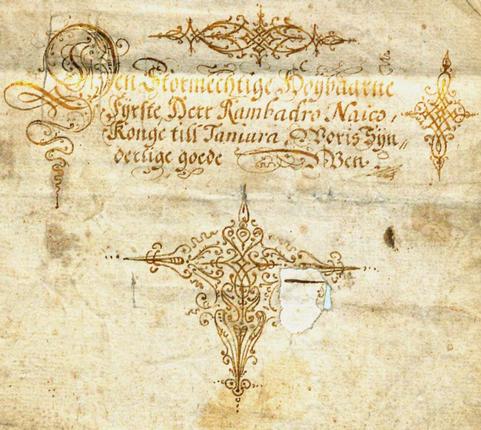
The National Archives of Denmark records that a fisherman from Karaikal was responsible for the modern history of Tranquebar.
On a glorious day in April 1620 AD., a Danish jaght (a three-masted, lightly armed merchant vessel of the 17 century), Øresund, was freebooting around Karaikal on the south-east coast of India, when a fleet of six galleys sent by Andre Botelho da Costa, the Portuguese governor of Jaffna, attacked it. Its captain, Roeland Crappe, and twelve of his crew escaped thanks to the aid of a fisherman.
A list of salaries found in the Danish National Archives reveals a stunning secret: “Cuti’s mother, a woman whose husband (was he also Cuti’s father?), saved the life of General Crappe when he lost his ship, Øresund, outside Carical” was paid one pardou every month for 25 years in gratitude for saving Crappe’s life. The jaght was totally wrecked, and the rest of the crew captured and murdered by the Portuguese. Two of the heads were displayed on stakes to warn the enemies. Earlier the jaght had captured several small Portuguese junks laden with rice and areca nuts on the east coast and auctioning goods with the permission of the king of Kandy.
Roeland Crappe managed to reach the court of Raghunatha Nayak at Tanjore, whom he had known earlier. Crappe must have expressed the wishes of his employer, Christian IV of Denmark, to set up trade relations in south-east Asia to Raghunatha Nayak. A letter by Raghunatha Nayak on a gold-foil asserts: “We order the creation of a port named Tharangampadi here and allow the export of pepper to that country (Denmark) as it is rare there.” A fisherman from Karaikal was thus responsible for the modern history of Tranquebar! Raghunatha Nayak signed the official treaty in Portuguese on November 19, 1620. Ove Gedde, a barely 23-year-old Admiral appointed by Christian IV, as the leader of a Danish fleet concluded the formal treaty on behalf of the Danes.
The National Archives in Copenhagen, Denmark, is a treasure house of records, dealing with the history of Tanjore and Tranquebar of 17 to 19 centuries. The Royal Library and the National Museum in Copenhagen house more than 350 palm-leaf collections from India from old almanacs to the diaries of local catechists to Arunachala Kavirayar’s Rama Natakam. As is often said, history is usually written by the conquerors and thus becomes one-sided. When available, history needs to be studied from both sides — and here the records in Denmark come as a great help.
Most historians assume that Raghunatha Nayak ruled between 1600 and 1634. Vriddhagirisan, an authority on the Nayaks of Tanjore, writes: “Considering the duration of all the individual reigns of the Tanjore Nayaks, it becomes evident that Raghunatha, the most illustrious ruler of this family had but a relatively short reign and his death will have to be placed about AD 1634.” On the question of who succeeded Raghunatha Nayak, Indian historians disagree. On the successor to the throne, Vriddhagirisan assumes that it was Vijayaraghava Nayak. He writes: “Vijayaraghava’s accession must have taken place in the year 1633 and that it was celebrated sometime before the death of Raghunatha.” There are many claims and counter-claims. Vriddhagirisan mentions two sons of Raghunatha, namely Achyuta and Ramabhadra, and Vijayaraghava would appear to the eldest son according to the genealogy given in the Raghunathabhudayam of Vijayaraghava Nayak. At the same time, Vriddhagirisan also cites a Jesuit letter: “Two brothers of the (Vijayaraghava) Nayaka, whom he had shut up in prison, after pulling out their eyes to remove all possibility of succeeding him… Ramabhadra could not have been on the direct line of succession… it is not quite known for certain, that Achyuta Vijayaraghava was also called Achyuta Ramabhadra.”

The Danish records are certain. Ove Gedde left three diaries after his strenuous voyage. He noted down everything. These diaries were then transcribed by Johann Heinrich Schlegel and are available as Google books. On November 4, 1620, Gedde notes, “I paid a visit to the eldest son of the Nayak and the throne follower, who requested me to visit him often.” On November 7: “the same day, the Nayak requested me to visit his middle son, who had complained that I had not paid him a visit.” It is obvious that Raghunatha Nayak had at least three sons. Citing a letter from Roeland Crappe written on September 17, 1628 from Masulipatnam (the original letter is in the Archives), Schlegel writes: “Ragnato Naiche died early on 25 November 1626 and cremated the same day with 119 of his wives. His eldest son Rambadra succeeded him to the throne, and came with 100 men to the fortification of Dansburg (in Tranquebar) (Johann Heinrich Schlegel, Samlung zur Dänischen Geschichte, Münzkenntniss, Oekonomie und Sprache, Erster band, Viertes Stück, pp. 162-163).”
Hidden in the National Archives in Copenhagen for almost 400 years, there is an innocuous letter from Christian IV written from his castle at Frederiksborg on April 11, 1631. The letter affirms the affection of the King to the Nayak of Tanjore, and expresses his wish for a continuation of the relationship between the two countries. The letter itself is not significant — the Addressee is: “The mighty, royal Prince Ramabadro Naico, King of Tanjore, our specially good friend!” Evidently, after the death of Raghunatha Nayak in 1626, Ramabhadra Nayak succeeded his father until he was gruesomely relieved of his post by his younger brother, Achutha Vijaya Raghava Nayak in 1634 AD.
P.S. Ramanujam is Professor Emeritus in the Technical University of Denmark, Roskilde, Denmark. psramanujam@gmail.com
source: http://www.thehindu.com / The Hindu / Home> Features> Magazine / by P.S. Ramanujam / May 02nd, 2015